 Are you struggling to create a social media strategy for your business?
Are you struggling to create a social media strategy for your business?
Lacking insight into the social behaviors of your customers?
No data, no problem!
Chances are your competitors have done all the hard work and all you need to do is look for it.
In this post, I'll show you how to research the competition's social game plan so you can build a solid social media strategy of your own.
Finding the Fundamentals
When it comes to social media marketing, you need to answer a few fundamental questions:
- Should your business be on social media?
- What networks should you choose?
- How do you create a great profile?
- What type of content should you post, and when should you post it?
Everyone must answer these questions, including business owners who want to create a strategy for their own business, marketing managers who need to convince their CEO to invest in social media and consultants who create strategies for clients in a wide variety of industries.
Fortunately, you can find answers through the process of competitor research.
Keep reading to discover how to get insight on your competitors.
#1: Comparing Audience Size
While you shouldn’t obsess about how many fans or followers your competitors have, noting these numbers at the beginning of your campaign can help you answer the following important questions.

1. Should your business be on social media?
If your competitors have an audience on social media, whether it is 100 people or 100,000, the answer should be yes. Otherwise, your competitors are tapping into a customer base that your business could be completely missing out on.
2. Which networks should your business focus on?
Get World-Class Marketing Training — All Year Long!
Are you facing doubt, uncertainty, or overwhelm? The Social Media Marketing Society can help.
Each month, you’ll receive training from trusted marketing experts, covering everything from AI to organic social marketing. When you join, you’ll also get immediate access to:
- A library of 100+ marketing trainings
- A community of like-minded marketers
- Monthly online community meetups
- Relevant news and trends updates
Do all of your competitors have strong presences on some networks, such as Facebook, LinkedIn and Twitter, but not others, such as Pinterest? If the answer is yes, then it means two things: 1) businesses in your industry do not do well on Pinterest or 2) with creativity, you have a chance to reach a group of customers with little competition.
3. Have you reached all of your target audience?
Competitor research isn’t just limited to businesses starting their social media strategy. If you have been using social media for a while, but not getting results, take a look at the size of your competitors’ social media audiences to help you gauge whether you are reaching as many of your potential customers as possible, or whether you still have room to grow your network.
How to Compare Your Competitors’ Audience Size
First, you’ll want to figure out what social networks your competitors belong to. To do this, start by going to your competitors’ website and/or blog to see what social icons they list in their header, sidebar or footer.
Next, do a Google search for your competitors’ business name. Typically, the social networks they are most active on will appear in the first three pages of search results.
Once you’ve discovered the top networks your competitors use, you can collect their number of followers/fans simply by visiting their profiles and entering the numbers into a spreadsheet.
Alternatively, you can use the tools mentioned below to find, analyze and monitor your competitors’ audience size and growth.
Facebook Pages to Watch
If you already have a Facebook page, you can use the Pages to Watch section of your admin panel to add your competitors’ Facebook pages to see how many likes they have and monitor their like growth on a weekly basis.
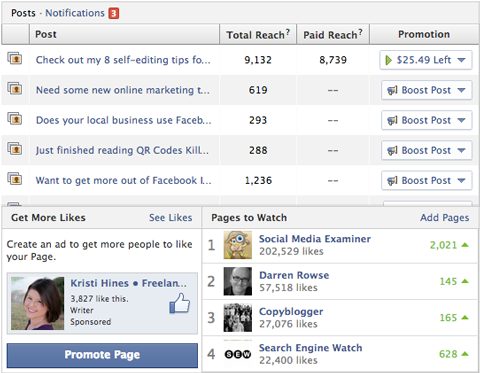
Simply use the Add Pages link to add new pages to your watch list. If you notice a particular competitor has a huge surge in growth, be sure to visit their page to see if they’re doing something exciting with their audience.
Twitter Counter
Twitter Counter allows you to look at your competitors’ follower growth for up to three months for free. You can look at one account at a time, or enter two accounts to compare Twitter followers and growth.
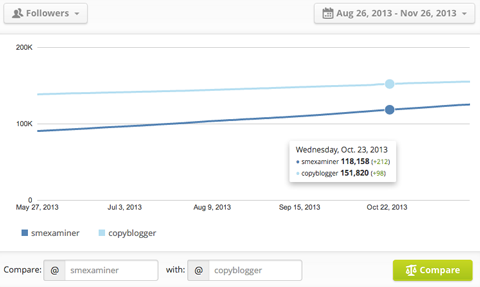
Wildfire
To get a quick comparison of the number of Twitter followers, Facebook likes or Google+ circlers your competitors have, try Wildfire’s free Who’s Winning in Social tool. It gives you a current snapshot of audience sizes by entering the profile/page name or URL of your competitors’ social presences.
Editorial Note: Who's Winning in Social is no longer an active tool.
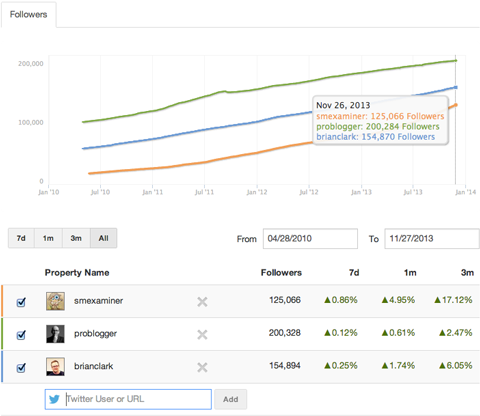
After you get stats for the initial three competitors, you can add more competitors if desired. The nice part is you can see not only their current audience size, you can also see their growth over the last three years.
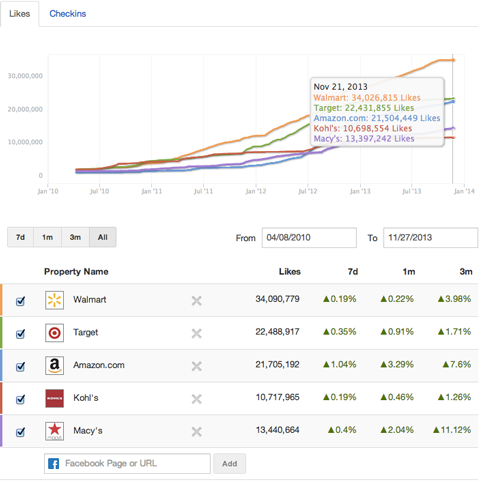
Rival IQ
Rival IQ is a competitor research and monitoring tool that allows you to enter an unlimited number of competitors and compare their social followings with yours.
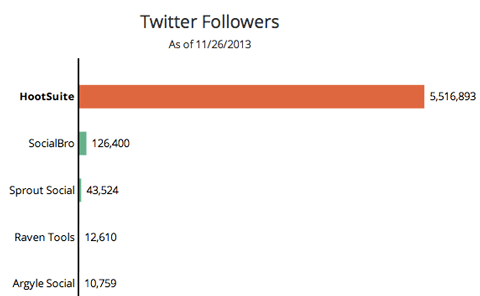
You can use Rival IQ to quickly glance at and regularly review Twitter followers, Facebook likes and Google+ circlers by counts for your accounts alongside your competitors’.
#2: Measuring Engagement
While audience size can tell you a lot, it can’t tell you everything. You certainly don’t want to emulate the style of a competitor that isn’t engaging with their audience, or one that has simply bought their followers and fans to inflate their numbers, not their quality of relationships. This is why engagement must be an important part of your competitor research.
So how do you measure your competitors’ engagement? The free reports provided by Simply Measured are a great place to start.
For Facebook, you can use the Facebook Competitive Analysis Report that will show you in-depth analysis of engagement for up to 10 Facebook pages with up to 250,000 likes. You will get graphs that show you the overall engagement by fans on posts by admins to each page, posts made by fans on each page, sharing engagement, people talking about the brand and an overview of which brands have the best engagement.
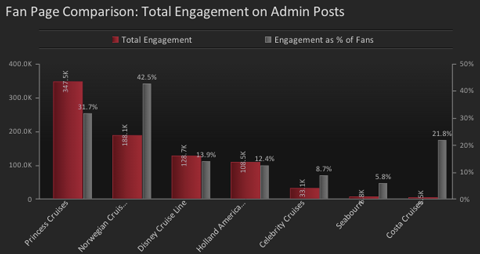
After the chart, you’ll get a table of the top posts from all of the pages with detailed breakdowns of the type of post (photo, video, text or link) and forms of engagement (likes, comments and shares).
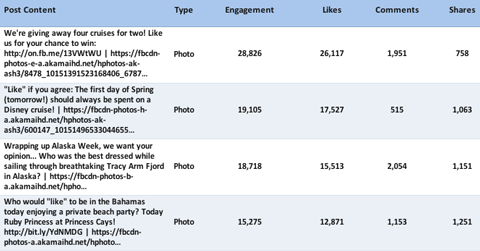
For engagement analysis of competitors on Twitter, try the Twitter Customer Service Analysis Report. This shows you details of how your competitor handles customer service on Twitter, along with the number of tweets a competitor sends compared to the retweets and mentions they receive.

Discover Proven Marketing Strategies and Tips
Want to go even deeper with your marketing? Check out the Social Media Marketing Podcast! Publishing weekly since 2012, the Social Media Marketing Podcast helps you navigate the constantly changing marketing jungle, with expert interviews from marketing pros.
But don’t let the name fool you. This show is about a lot more than just social media marketing. With over 600 episodes and millions of downloads each year, this show has been a trusted source for marketers for well over a decade.
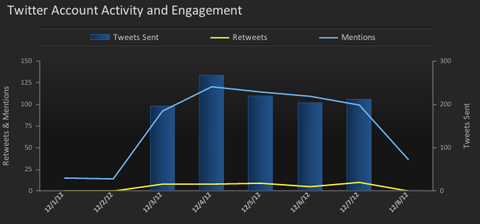
For engagement analysis of competitors on Google+, you can try their Google+ Page Report that will analyze any Google+ page with up to 100,000 circlers.
For Instagram engagement analysis, you can use the Instagram User Report that will analyze any Instagram user with up to 25,000 followers.
Both will show you how engaged the audiences of each account really are.
#3: Looking at Profile Setups
Once you’ve chosen a few networks to focus on based on your competitors’ audience size and engagement, the next thing you’ll want to consider is reviewing your top competitor’s profile setup. This can give you inspiration for designing your own profiles.
In particular, you’ll want to note how each of your competitors uses the following profile/page elements.
Cover Photos
Facebook pages, Google+ pages, LinkedIn company pages and Twitter profiles all allow you to have custom cover/header photos. If you have no idea how to design yours, perusing your competitors’ will definitely give you some ideas to work with.
You might find that some of your competitors use the same image for consistent branding like HubSpot does on Facebook, Twitter, Google+ and LinkedIn.
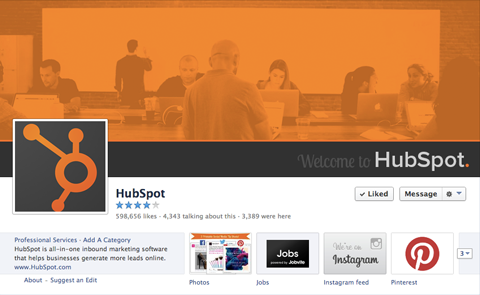
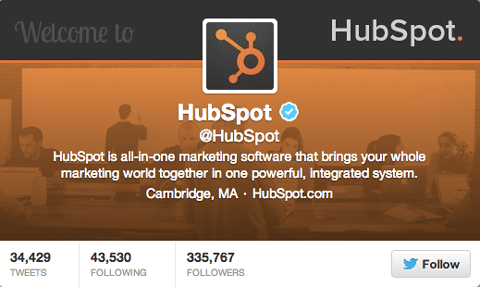
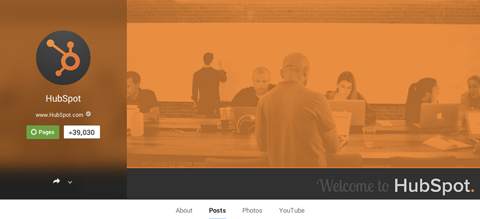
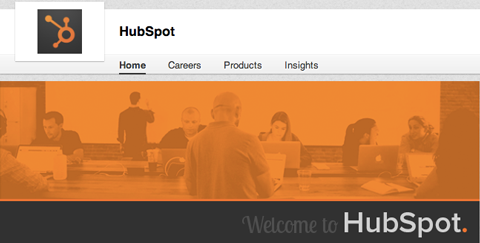
Or you might find your competitors do something a little different for each social network like Ford does on Facebook, Twitter, Google+ and LinkedIn.
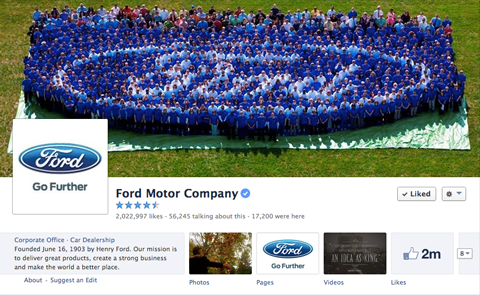

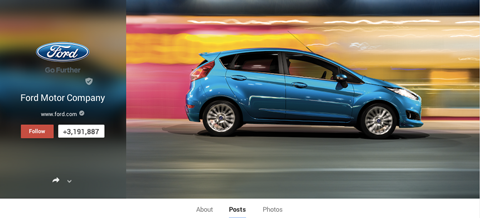

While you’re looking at cover/header photos, also note the use of profile photos/icons. Are your competitors using a photo of a person or logo? Depending on your industry and business type, this could make a big difference in connecting with your audience.
Descriptions
Next on the list of things to note is the descriptions your competitors use for their business. Why are bios, short descriptions and About information so important? It’s simple; your 160-character Twitter bio could be the first impression a potential customer gets of your business. You’ll want to make that count.
When you’re browsing through your competitors’ design, you can also copy and paste their descriptions into a Word document for reference. Or, if you used the Rival IQ tool mentioned earlier, you can see your competitors’ Twitter bios, Facebook descriptions, Google+ taglines and Google+ introductions all together.
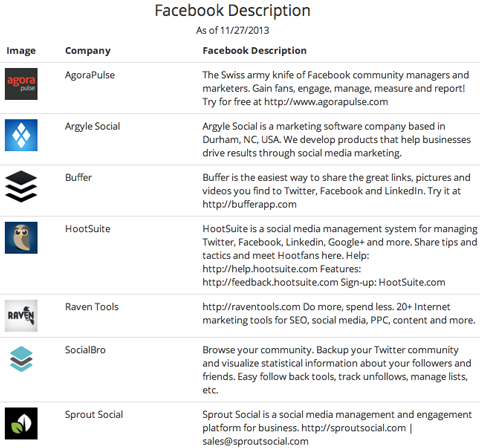
Links
If you want to get traffic back to your website from social media, strategic placement of your website links is key. While analyzing your competitors’ profiles, look at where they place links to their websites, what links they use (homepage, sales page, landing page, etc.) and what calls to action precede the link.
If you look back at the previous image showing the Facebook page descriptions of top social media management tools, you can see that most have a link in their description, and three out of five of those that included a link specifically ask their fans to try their software.
Analyze Content Posting
Last but not least is the content. After your profiles and pages are set up and you are working toward building your audience, your ongoing goal will be to post great content that keeps your followers and fans engaged with your business. Coming up with a content calendar for social media always leads to a lot of questions, including:
- How often should I post on different social networks? Do people following on Twitter expect more updates than those following on Facebook? Is once a day too much, or not enough?
- Which types of updates should I post? Should I use links, photos, videos, questions, quotes, etc.?
- What determines if a post is successful on social media? Should my main goal be retweets, likes, comments, shares or click-throughs?
Ok, so the last question should be determined by your business, but the answers to the first two questions can be learned from your competitors. Outside of scanning through each of your competitors’ posts and noting any posts that seem particularly successful in terms of engagement, you can use the following tools.
Simply Measured
Simply Measured has a few useful free tools.
If you really want to dig deep into analysis of a competitor’s posts, start with the free Facebook Content Analysis. This tool analyzes the last two weeks worth of posts and breaks down engagement by post type and per post.
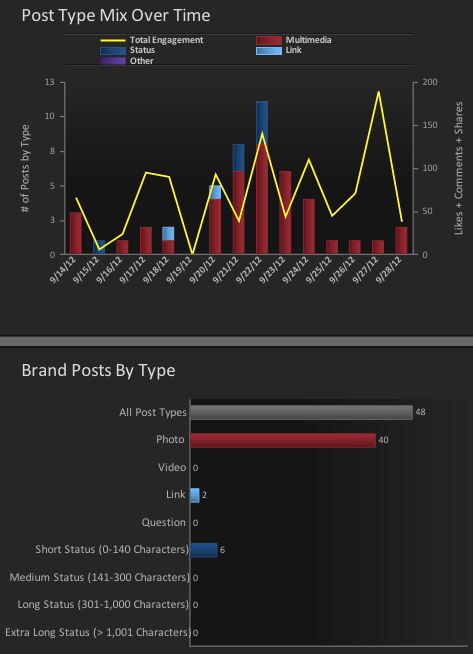
The Google+ Page Report and Instagram User Report also detail the top posts from your competitors based on engagement and type.
Rival IQ
Rival IQ allows you to see the top content from all of your competitors within the last 7–90 days, sorting content by the most overall engagement, likes, shares, comments, retweets, favorites and so on.
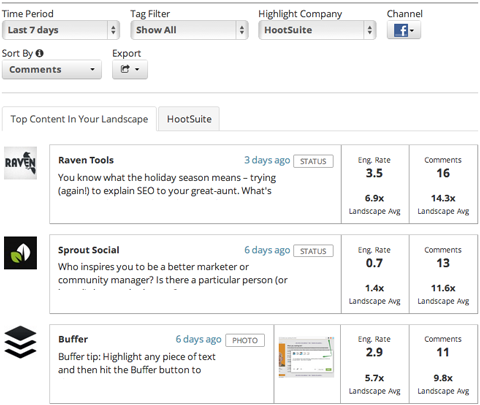
Between Simply Measured and Rival IQ, you should never run short of social posting inspiration!
In Conclusion
As you can see, competitor research can help you determine where you should focus your social media marketing campaign, how to get it started and ways to get engaged with your audience. This is the information you need to create a strong social media strategy for your business.
What do you think? Have you performed social media competitor research? If so, what did you learn? What tools would you recommend? Please share in the comments!
Photos from Shutterstock.
Attention Agency Owners, Brand Marketers, and Consultants

Introducing the Marketing Agency Show–our newest podcast designed to explore the struggles of agency marketers.
Join show host and agency owner, Brooke Sellas, as she interviews agency marketers and digs deep into their biggest challenges. Explore topics like navigating rough economic times, leveraging AI, service diversification, client acquisition, and much more.
Just pull up your favorite podcast app, search for Marketing Agency Show and start listening. Or click the button below for more information.

